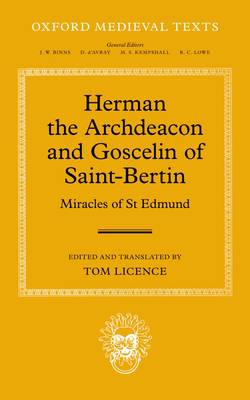
- Afhalen na 1 uur in een winkel met voorraad
- Gratis thuislevering in België vanaf € 30
- Ruim aanbod met 7 miljoen producten
- Afhalen na 1 uur in een winkel met voorraad
- Gratis thuislevering in België vanaf € 30
- Ruim aanbod met 7 miljoen producten
Zoeken
Herman the Archdeacon and Goscelin of Saint-Bertin
Miracles of St Edmund
€ 348,45
+ 696 punten
Omschrijving
St Edmund was medieval England's patron saint, and at his abbey, two major Latin miracle collections were compiled: one in the 1090s by Herman the Archdeacon, an historian trained in the schools of Lorraine; the other c. 1100 by an anonymous hagiographer who rewrote and expanded Herman's work. Herman's Miracles, an important text for the history of the realm and East Anglia in particular, is edited and translated here in its full fifty chapters for the first time, along with a shorter version intended for wider circulation. The second miracle collection, never before in print, is also presented for the first time and attributed to the Flemish hagiographer Goscelin of Saint-Bertin. Together the collections illustrate a rapid turnover of hagiography, connected to a change of leadership at the abbey of Bury St Edmunds. These works illustrate the evolution of historical writing, applied to the affairs of an exceptional international cult. The introduction revises the history of Bury St Edmunds from its foundations to c. 1100, rejecting old assumptions, adding to our knowledge of Herman's background, and proposing a context and attribution for the second collection which will alter the debate on Goscelin's career. A poem attacking Bishop Herbert Losinga (1091-1119) for simony is
also included, edited from previously undiscovered textual witnesses, and linked to Herman and the factional divisions behind the two miracle collections. This volume makes the subject accessible to the full range of scholars interested in Edmund and Anglo-Norman England by providing editions and translations for the first time. Its arguments clear up much of the confusion surrounding the history of the cult and the abbey. It will remain invaluable to literary scholars and historians alike.
also included, edited from previously undiscovered textual witnesses, and linked to Herman and the factional divisions behind the two miracle collections. This volume makes the subject accessible to the full range of scholars interested in Edmund and Anglo-Norman England by providing editions and translations for the first time. Its arguments clear up much of the confusion surrounding the history of the cult and the abbey. It will remain invaluable to literary scholars and historians alike.
Specificaties
Betrokkenen
- Uitgeverij:
Inhoud
- Aantal bladzijden:
- 536
- Taal:
- Engels, Latijn
- Reeks:
Eigenschappen
- Productcode (EAN):
- 9780199689194
- Verschijningsdatum:
- 17/06/2014
- Uitvoering:
- Hardcover
- Formaat:
- Genaaid
- Afmetingen:
- 216 mm x 142 mm
- Gewicht:
- 768 g

Alleen bij Standaard Boekhandel
+ 696 punten op je klantenkaart van Standaard Boekhandel
Beoordelingen
We publiceren alleen reviews die voldoen aan de voorwaarden voor reviews. Bekijk onze voorwaarden voor reviews.










